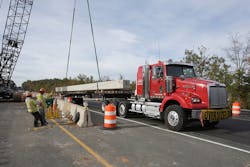White House delivers multi-year transportation plan to Congress
With federal funding for highways and transit facing a May expiration date, the Obama administration on Monday officially sent its half-billion dollar, six-year transportation plan to Congress.
The spending guide, touted frequently by Transportation Secretary Anthony Foxx as a “new and improved” version of last year’s Grow America Act, relies on a change in the way corporations are taxed on overseas profits to make up for the shortfalls in gasoline and diesel taxes that support the Highway Trust Fund.
“Our proposal provides a level of funding and also funding certainty that our partners need and deserve,” Foxx said, referring to state and local transportation agencies. “This is an opportunity to break away from 10 years of flat funding, not to mention these past six years in which Congress has funded transportation by passing 32 short-term measures.”
Indeed, the Department of Transportation reported that Tennessee, Arkansas, Delaware, and Wyoming have delayed more than a billion dollars in projects. And Georgia alone has set aside $715 million in projects, while Mississippi has shifted its transportation dollars only to smaller maintenance efforts.
The proposal, whose framework was contained in the administration’s 2016 budget request, allocates $317 billion for highways over the six years, an average increase of 29% above the current funding level. Along with $115 billion for transit, it provides $18 billion to establish a new multimodal freight grant program to fund projects that will improve the movement of goods across the country.
The plan also triples the budget of the National Highway Traffic Safety Administration’s (NHTSA) automobile defects office.
However, Congress did not act on last year’s White House proposal and lawmakers have been critical of the one-time, mandatory tax provision, also called “repatriation.”
Congress remains split, however, on alternative, long-term funding sources, and both Republicans and Democrats are struggling to find ways to pay for even a temporary highway bill that would maintain federal spending until a multi-year program can be worked out.
“It is clear to me that transportation is still a bipartisan issue, and I am really encouraged to see members of both parties working to get something done,” Foxx said. “During these next two months, though, all of us who work in Washington need to be relentless in trying to get to ‘yes’ on a bill that is truly transformative and that brings the country together.”
About the Author
Kevin Jones
Editor
Kevin has served as editor-in-chief of Trailer/Body Builders magazine since 2017—just the third editor in the magazine’s 60 years. He is also editorial director for Endeavor Business Media’s Commercial Vehicle group, which includes FleetOwner, Bulk Transporter, Refrigerated Transporter, American Trucker, and Fleet Maintenance magazines and websites.
Working from Beaufort, S.C., Kevin has covered trucking and manufacturing for nearly 20 years. His writing and commentary about the trucking industry and, previously, business and government, has been recognized with numerous state, regional, and national journalism awards.

